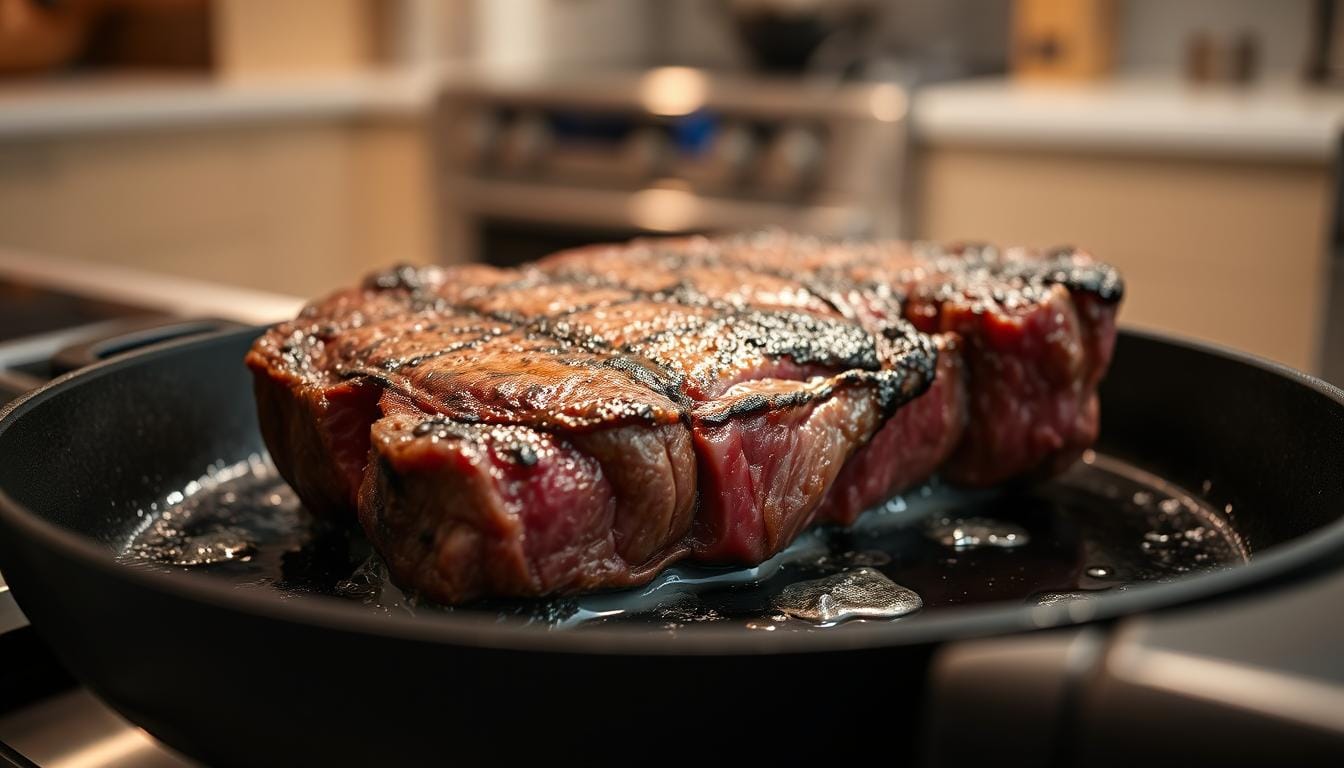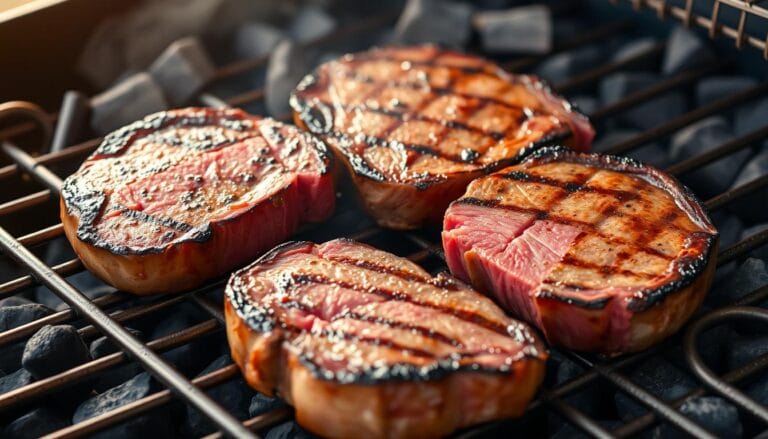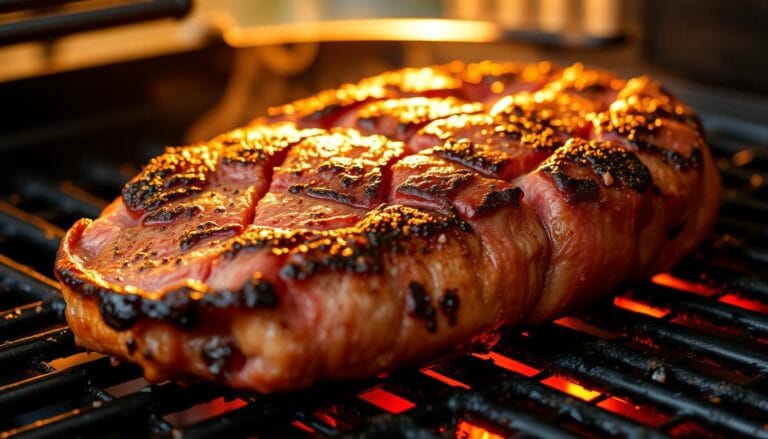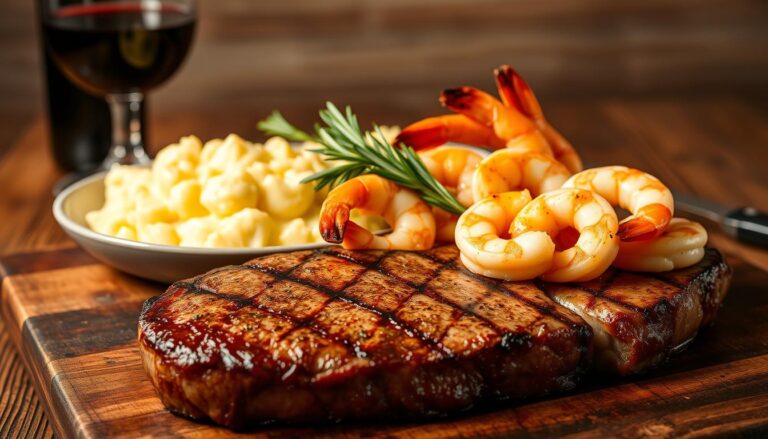How to Cook a Rump Steak Medium Well – Perfectly Done Every Time
Table of Contents
How to Cook a Rump Steak Medium Well : Perfectly Done Every Time
A perfectly cooked rump steak can make any meal unforgettable. Getting it just right to medium well might seem hard. But, with the right methods, you can impress everyone with your cooking.
Whether you’re an expert chef or just starting, cooking rump steaks to perfection is easy. This guide will show you how, from picking the right cut to serving a dish that will wow your guests.
Key Takeaways
- Understand the characteristics of a great rump steak
- Learn the best practices for preparing your steak for cooking
- Discover the techniques for achieving a perfect medium well doneness
- Explore tips for consistent results every time you cook
- Impress your guests with a restaurant-quality dish in the comfort of your own home
Understanding Rump Steak and Its Qualities
To cook rump steak well, you need to know what it is and its special qualities. Rump steak comes from the cow’s hindquarters. It’s known for its rich taste and tender texture when cooked right.
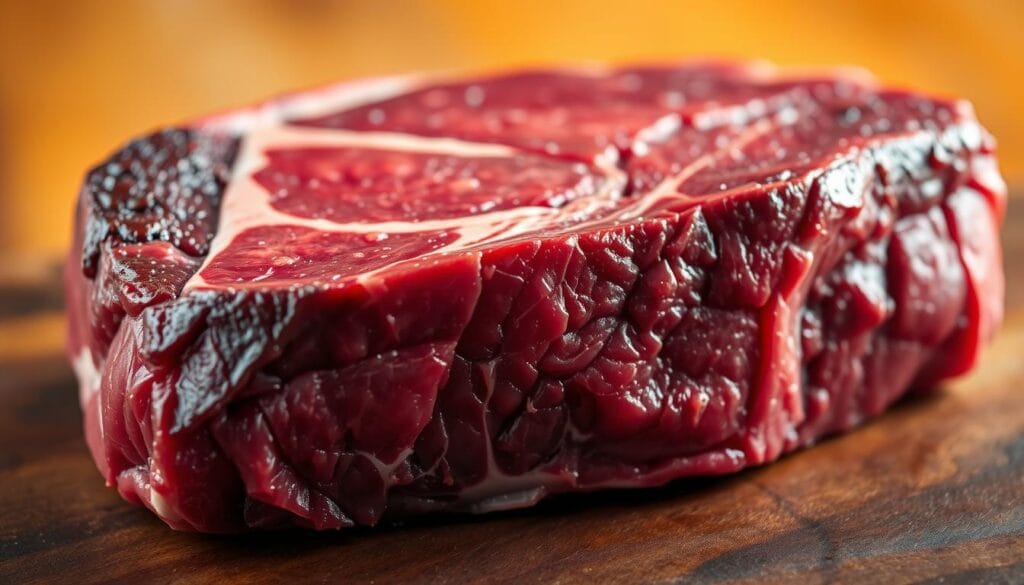
What is Rump Steak?
Rump steak is a favorite among beef lovers. It has a strong flavor and a mix of tenderness and chewiness. It comes from the cow’s rear, which affects its texture and taste.
The quality of rump steak comes from its marbling. Marbling is the fat inside the meat. It makes the steak taste better, feel softer, and stay juicier when cooked.
Different Cuts of Rump Steak
There are many types of rump steak, each with its own traits. The main types are:
- Center Cut: It’s tender and even, perfect for cooking evenly.
- Cap: This part is very tender and full of flavor, great for fancy dishes.
- Tail: It’s leaner and less tender but full of flavor.
| Cut | Tenderness | Flavor |
|---|---|---|
| Center Cut | High | Rich |
| Cap | Very High | Intensely Rich |
| Tail | Moderate | Robust |
Why Choose Rump Steak?
Choosing rump steak is a smart move because it’s affordable. It has a great taste, tenderness, and price, making it perfect for any meal.
Rump steak is also very versatile. You can grill, pan-sear, or roast it in the oven. This lets you try different cooking methods to find your favorite way.
Preparing Your Rump Steak for Cooking
Getting your rump steak ready is key to a great meal. Start with the right steps to cook it perfectly.
Selecting the Right Rump Steak
Choose a rump steak that’s 1-1.5 inches thick. This thickness is perfect for a medium-well doneness. It should have good marbling for tenderness and flavor. Look for a deep red color to ensure freshness and quality.
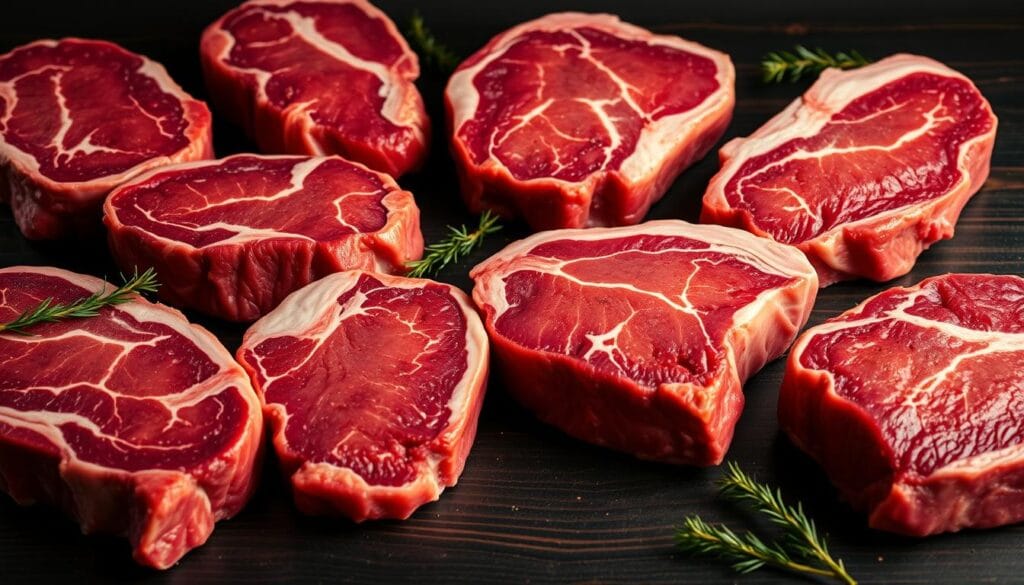
Necessary Tools and Equipment
You’ll need some essential tools to cook your steak right. These include:
- A reliable meat thermometer for accurate temperatures.
- A heavy-bottomed skillet or grill for high heat.
- Tongs for safely handling the steak.
- A sharp knife for trimming fat if needed.
| Tool/Equipment | Purpose |
|---|---|
| Meat Thermometer | Ensures accurate internal temperature |
| Heavy-Bottomed Skillet/Grill | Achieves high heat for searing |
| Tongs | Handles the steak safely |
| Sharp Knife | Trims excess fat if necessary |
Seasoning Your Steak
Bring your steak to room temperature before cooking. This ensures even cooking. Season with salt 45 minutes before or right before cooking. Add pepper and other seasonings like garlic powder or herbs to enhance the flavor without overpowering it.
Cooking Methods for Rump Steak
To cook a rump steak medium well, you can use grilling, pan-searing, or oven roasting. Each method has its own way to get the steak just right. Learning these techniques makes you a more skilled cook.
Grilling Rump Steak
Grilling adds a smoky taste and a nice char to the steak. First, heat your grill to high. Clean the grates to avoid sticking. Season the steak before grilling.
Grill the steak for 5-6 minutes on each side. It should reach 145-150°F inside. Let it rest for a few minutes before you serve it.
Pan-Searing Techniques
Pan-searing creates a crispy crust on the steak. Heat a skillet or cast-iron pan over high heat. Add a bit of oil and then the steak.
Sear for 2-3 minutes on each side. Then, lower the heat to medium. Cook until it’s medium well, checking with a thermometer. Make sure not to overcrowd the pan.
Oven Cooking: A Step-by-Step Guide
Oven cooking is good for even heat and keeping the steak moist. Preheat your oven to 400°F (200°C). Sear the steak in a hot pan for 1-2 minutes on each side.
Then, put it on a baking sheet and roast. Cook for 10-12 minutes, or until it’s medium well. Use a thermometer to check. Let it rest before slicing and serving.
Mastering these cooking methods lets you make a flavorful and tender rump steak medium well. Choose from grilling, pan-searing, or oven cooking, depending on your preference.
Achieving the Perfect Medium Well Steak
To cook a rump steak medium well, you need to know about different doneness levels. Doneness is how cooked your steak is. It’s key for a great meal.
Understanding Doneness Levels
Steak doneness levels include rare, medium rare, medium, medium well, and well done. Each level is based on the steak’s internal temperature and color. For medium well, you want a warm pink center with mostly brown.
| Doneness Level | Internal Temperature (°F) | Description |
|---|---|---|
| Rare | 120-130 | Red throughout, cool center |
| Medium Rare | 130-135 | Pink throughout, warm red center |
| Medium | 140-145 | Pink center, mostly brown |
| Medium Well | 150-155 | Warm pink center, mostly brown |
| Well Done | 160+ | No pink, fully brown |
Ideal Cooking Temperatures for Medium Well
For a medium well rump steak, aim for an internal temperature of 150-155°F. But, remove it from heat at 145-150°F. This prevents overcooking.
“The key to a great steak is not just the cooking, but also the resting. Letting it sit allows the juices to redistribute, making the steak more tender and flavorful.”
Resting Your Steak: Why It’s Important
Resting your steak is key for a perfect medium well. After cooking, let it rest for 5-10 minutes. This makes the steak tender and juicy.
To rest right, cover your steak with foil. This keeps it warm without trapping steam. Steam can ruin the crust.
By knowing about doneness, cooking to the right temperature, and resting, you’ll get a great medium well rump steak every time.
Tips for Enhancing Flavor and Texture
To make your rump steak truly special, try a few simple tricks. These methods will elevate your steak, making every bite unforgettable.
Marinating Your Rump Steak
Marinating adds flavor and tenderizes your steak. The marinating time varies, from 2 to 24 hours. A good marinade has acidic ingredients like vinegar, oils, and spices. For instance, olive oil, garlic, and herbs like thyme and rosemary can give your steak a rich taste.
Key Marinade Ingredients:
- Acidic ingredients (vinegar, citrus juice)
- Oils (olive oil)
- Spices and herbs (garlic, thyme, rosemary)
Using Butter and Herbs for Flavor
Butter and herbs during cooking add a rich flavor. This method, called butter basting, involves melting butter with garlic and herbs. As you baste the steak, the butter melts, adding a deep flavor.
“The addition of butter and herbs during cooking can elevate the flavor of your steak, making it more complex and enjoyable.”
Searing Techniques for a Better Crust
A good sear changes the steak’s texture and flavor. Pat the steak dry before searing to remove moisture. A hot pan is key for a quick sear, creating a crust. Pressing the steak briefly at the start helps the crust form better.
Searing Tips:
| Technique | Description | Benefit |
|---|---|---|
| Pat dry | Remove excess moisture from the steak | Better crust formation |
| Hot pan | Heat the pan to the right temperature | Quick searing, better crust |
| Press down | Press the steak down briefly during searing | Maximizes surface contact, enhances crust |
Common Mistakes to Avoid
To cook a rump steak perfectly, it’s important to know the mistakes to avoid. Cooking a steak to the right doneness can be tricky. But, by steering clear of common errors, you can improve your cooking.
There are several mistakes that can ruin a rump steak. Here are some key errors to watch out for.
Overcooking: Signs to Watch For
Overcooking is a common mistake when cooking a rump steak. Signs of overcooking include excessive firmness when pressed, shrinkage at the edges, and changes in the aroma of the cooking meat. To avoid overcooking, keep a close eye on the steak’s temperature and texture.
Skipping the Resting Period
Skipping or shortening the resting period is another mistake. Resting allows the juices to redistribute within the meat, making it more tender and flavorful. Without resting, the steak can end up dry.
Choosing the Wrong Cooking Method
Choosing the wrong cooking method for your rump steak can also lead to bad results. For example, very thick cuts may need the reverse sear method. This ensures even doneness without charring the outside.
| Mistake | Description | Consequence |
|---|---|---|
| Overcooking | Cooking the steak beyond medium well | Steak becomes tough and dry |
| Skipping Resting | Not allowing the steak to rest after cooking | Juices run out, making the steak less tender |
| Wrong Cooking Method | Using a method not suited for the steak’s thickness | Uneven cooking, potentially charring the exterior |
By understanding and avoiding these common mistakes, you can cook a rump steak medium well perfectly. Remember, the key to a great steak is not just in the cooking but also in the preparation and resting.
Sides and Pairings for Rump Steak
To make your medium well rump steak dinner special, try these classic and new ideas. The right sides and pairings can make a simple steak dinner unforgettable.
Best Side Dishes to Complement Rump Steak
Choosing sides is all about balancing the rich flavor of the steak. You want contrasting textures and flavors. Here are some great options:
- Roasted vegetables like asparagus or Brussels sprouts add crunch and a bit of bitterness to balance the richness.
- Garlic mashed potatoes or crispy roasted potatoes bring a comforting touch.
- Fresh salads with light vinaigrettes offer a refreshing contrast to the savory steak.
These sides not only match the flavor of the rump steak but also add variety to your plate.
Wine Pairing Suggestions
Finding the right wine for your medium well rump steak can make the meal even better. Here are some top picks:
- California Cabernet Sauvignon pairs well with the charred exterior of a grilled steak thanks to its bold tannins.
- Washington State Merlot offers a smoother, fruit-forward taste that complements the steak’s tenderness.
- Oregon Pinot Noir has a light to medium body and red fruit flavors, providing a nice contrast to the steak’s richness.
These wines are chosen for their ability to enhance the steak’s flavor without overpowering it.
Creative Sauces for Enhanced Flavor
Sauces can add a new layer of flavor to your rump steak. Here are some great options:
| Sauce Type | Description | Flavor Profile |
|---|---|---|
| Peppercorn Sauce | A creamy sauce with a subtle kick | Rich, slightly spicy |
| Béarnaise Sauce | A classic French sauce made with butter, eggs, and herbs | Buttery, slightly tangy |
| Chimichurri | A bright, herby sauce from Argentina | Fresh, zesty |
| Bourbon-Mushroom Sauce | A savory sauce with the depth of mushrooms and bourbon | Umami, slightly sweet |
Each sauce brings a unique flavor that can enhance your medium well rump steak. They make the dish more complex and satisfying.
Storing Leftover Rump Steak
Leftover rump steak can be just as tasty as fresh if stored right. Keeping it tender and flavorful means paying attention to how you refrigerate, reheat, and reuse it.
Best Practices for Refrigeration
First, cool the steak completely before refrigerating. Wrap it tightly in plastic or foil to stop moisture loss. Airtight containers also work well. Food safety says you can store cooked steak in the fridge for 3 to 4 days.
Reheating Techniques for Optimal Taste
Reheating steak without overcooking it is tricky. Try using a low oven with a bit of broth or wine wrapped in foil. Sous vide reheating is also great for keeping the steak just right. Chef Gordon Ramsay says, “The key to a great steak is not just in the cooking, but in the resting and reheating.”
“The way you cook, the way you reheat, it’s all about respect for the ingredient.” –
Creative Ideas for Leftover Steak Dishes
There are many ways to use leftover rump steak. Slice it thin for steak sandwiches on a crusty baguette. Or chop it for salads, stir-fries, or breakfast with eggs. The options are endless, and a little creativity can make your steak last longer.
Some ideas include:
- Steak salad with arugula and parmesan
- Steak sandwiches with caramelized onions
- Steak and eggs breakfast skillet
- Stir-fry with bell peppers and soy sauce
By following these tips, you can enjoy your leftover rump steak while keeping it fresh and reducing waste.
Frequently Asked Questions About Rump Steak
Exploring cooking rump steak can raise many questions. You might wonder how to get it just right. This section aims to answer some common questions to boost your confidence in cooking rump steak.
Cooking Time for Rump Steak
The cooking time for rump steak varies. It depends on the steak’s thickness and the cooking method. For a 1-inch thick steak, cooking it for 4-5 minutes on each side can achieve medium well doneness.
Using a meat thermometer is the best way to check the steak’s doneness. For medium well, the internal temperature should be around 150°F to 155°F (65°C to 68°C).
Grilling Rump Steak
Grilling rump steak adds a smoky flavor and a nice char. To grill it well, preheat your grill to the right temperature. Also, manage the steak’s position for the best results.
For medium well, grill the steak over medium-high heat for a few minutes on each side. Then, finish it over lower heat to avoid overcooking.
Determining Doneness
There are several ways to check if your rump steak is medium well. While a meat thermometer is the most accurate, you can also use the finger test or look for visual cues.
- The finger test involves touching the steak and comparing its firmness to the flesh between your thumb and index finger when you touch them together.
- Visual cues include checking the color of the steak; for medium well, there should be a hint of pink in the center.
But, these methods are not as reliable as a thermometer. So, it’s best to use a combination of these techniques to ensure your steak is cooked just right.
Safety Tips When Cooking Steak
To have a safe and fun meal, follow these key safety tips for cooking steak. Cooking rump steak needs careful handling to avoid food sickness and kitchen mishaps.
Food Safety Guidelines
It’s important to follow food safety rules when dealing with raw meat like rump steak. Always keep raw meat away from other foods to stop bacteria spread. Use separate cutting boards and tools for raw meat, and wash your hands and surfaces well after touching raw beef. The USDA says, “separate raw meat, poultry, and seafood from other foods to prevent the spread of bacteria.”
Safe Handling and Preparation
Safe handling is key to avoid contamination and make sure your steak is safe to eat. When thawing frozen rump steak, use the fridge or cold water, changing the water every 30 minutes. Never thaw at room temperature. Before cooking, let raw steak sit at room temperature for no more than 2 hours, or 1 hour if it’s over 90°F (32°C). For more tips on safe handling, check out tophealtyrecipes.com.
Cooking at the Right Temperature
Cooking your rump steak to the right temperature is key for safety. The USDA says cook whole cuts like steak to at least 145°F (63°C), then rest for 3 minutes. For a medium-well steak, cook to 150-155°F (66-68°C). Use a food thermometer for accuracy. Remember, “when in doubt, throw it out” – if unsure if your steak is cooked safely, it’s safer to be cautious.
By sticking to these safety tips, you can enjoy a perfectly cooked rump steak while keeping your kitchen and dining area safe.
Understanding Steak Quality Grading
To cook a perfect rump steak, knowing the USDA beef grading system is key. This system looks at marbling, maturity, and color to judge beef quality.
What is Beef Grading?
Beef grading checks the quality and yield of beef. The USDA’s system is not mandatory but is widely used. It considers marbling, maturity, and meat color and texture.
Prime, Choice, and Select Grades Explained
The USDA sorts beef into categories like Prime, Choice, and Select. These are the most important for people buying beef.
- Prime: The top grade, known for lots of marbling. This makes the meat tender and flavorful. Prime rump steaks are perfect for special events.
- Choice: Offers high quality with some marbling. Choice rump steaks are tasty and affordable, great for everyday meals.
- Select: Leaner with less marbling. It’s a good choice for those who want less fat. But it might not be as tender or flavorful as Prime or Choice.
How Grading Affects Flavor and Tenderness
The grade of your rump steak greatly affects its taste and tenderness, more so when cooked to medium well. Higher grades like Prime stay juicier and tastier because of their marbling. When picking a grade, think about your budget and the event. Prime is ideal for special times, while Choice is better for everyday meals.
Choosing a rump steak based on quality grading can really enhance your meal. Knowing the differences between Prime, Choice, and Select helps you pick what fits your taste and budget.
The Role of Resting Steak
Resting your rump steak is a key step many cooks miss. It’s vital for a tender and juicy medium well doneness. It’s tempting to slice into the steak right away after cooking. But, letting it rest makes a big difference in your dish’s quality.
Resting Time for Different Thickness
The resting time depends on the steak’s thickness. A 5 to 10 minute rest is usually good, with thicker steaks needing more time. A 1-inch thick steak usually needs a 5-minute rest.
- For steaks 1 inch or less in thickness, rest for 5 minutes.
- For steaks between 1 and 1.5 inches, rest for 7-8 minutes.
- For steaks over 1.5 inches, rest for 10 minutes or more.
Benefits for Flavor and Juiciness
Resting your steak relaxes the muscle fibers. This lets the juices spread evenly through the meat. It’s key for keeping moisture in the steak, making it more flavorful and tender.
Key benefits of resting your steak include:
- Improved juiciness due to retained moisture.
- Enhanced flavor as the juices redistribute.
- A more tender texture as the muscle fibers relax.
Optimal Resting Techniques
Using the right techniques is key for resting. Tenting your steak with foil helps keep it warm without making the crust soggy. Place it on a wire rack or plate to let air circulate and cool evenly.
Tips for optimal resting:
- Tent the steak loosely with foil to retain heat.
- Use a wire rack to allow air circulation.
- Time your rest period to coincide with serving your side dishes.
Cooking Rump Steak for Special Occasions
Whether it’s a date night or a barbecue, mastering the art of cooking rump steak can elevate any dining experience. To make your special occasions even more memorable, we’ll explore how to cook rump steak to perfection. We’ll also show you how to impress your guests and create a delightful atmosphere.
Perfect Steak for Date Night
Cooking rump steak for a date night can be a romantic and intimate experience. To create a warm ambiance, consider dimming the lights and lighting some candles. Serve your steak with a side of garlic mashed potatoes or roasted vegetables to complement its rich flavor.
For an added touch, you can also prepare a special sauce to go with your steak. Some popular options include peppercorn sauce, Béarnaise sauce, or a simple garlic butter.
| Date Night Ideas | Description |
|---|---|
| Candlelight Dinner | Create a warm ambiance with candles and dim lighting. |
| Special Sauce | Prepare a peppercorn or Béarnaise sauce to complement your steak. |
| Wine Pairing | Pair your steak with a glass of red wine, such as Cabernet Sauvignon or Merlot. |
Preparing for a Barbecue
When preparing for a barbecue, cooking rump steak for a crowd can be a bit challenging, but with some planning, you can achieve great results. Make sure to marinate your steak beforehand to enhance its flavor and tenderness.
To cook rump steak for a crowd, consider grilling multiple steaks at once. Use a thermometer to ensure that your steaks are cooked to the right temperature. For medium-well rump steak, aim for an internal temperature of 150°F to 155°F.
Impressing Guests with Your Cooking Skills
To impress your guests with your cooking skills, consider adding some interactive elements to your meal. Tableside slicing or finishing with flambéed butter can add a touch of drama and make the experience more engaging.
Make sure to plan ahead and manage your cooking time effectively. Use a timer to ensure that your steak is cooked to perfection, and have all your sides and sauces ready to go.
- Plan your cooking schedule in advance.
- Use a thermometer to ensure the right doneness.
- Add interactive elements like tableside slicing or flambéed butter.
The Art of Slicing Rump Steak
After cooking your rump steak to perfection, it’s time to slice it right. Slicing isn’t just about cutting it up; it’s about making your meal better. The way you slice can make your steak tender and look great.
Slicing for Maximum Tenderness
To make your steak tender, slice it against the grain. The grain is the muscle direction. Cutting against it makes the steak soft to chew. Look at your steak to see the grain lines. Slice across these lines for the best tenderness.
Tips for Slicing Against the Grain:
- Examine the steak to identify the grain direction.
- Position your knife at a 45-degree angle to the cutting board.
- Slice the steak in smooth, even strokes.
Techniques to Enhance Presentation
How you present your steak can make a big difference. Slice your steak to about ¼ to ½ inch for a medium well. Angled cuts can make each slice look better.
Arrange the slices nicely on your plate. Try a fan pattern or a neat line. Add fresh herbs or sauce for extra flair.
Presentation Ideas:
- Fan out the slices on the plate.
- Arrange slices in a pattern.
- Garnish with fresh herbs or a complementary sauce.
Recommended Knife Types for Cutting
A sharp knife is key for slicing your steak. Use a carving knife or steak knife for clean cuts. These knives help keep the juices in.
Keep your knife sharp to avoid tearing the meat. A dull knife can ruin your steak’s look and taste.
Knife Maintenance Tips:
- Sharpen your knife regularly.
- Store your knife properly to maintain its edge.
- Clean your knife immediately after use.
Mastering steak slicing can make your meal even better. Whether it’s for a special event or a simple dinner, slicing with care will impress everyone.
Conclusion: Mastering Your Rump Steak
Cooking a rump steak to medium well is an art that needs practice and patience. By following the steps in this article, you’ve started your journey to becoming a steak expert. Learning how to cook a rump steak medium well is key to a juicy and flavorful steak.
Practicing Techniques
As you keep practicing, you’ll see how different seasonings and cooking methods can improve your steak. Try marinating your steak or using different oils for pan-searing. The secret to mastering rump steak is to keep practicing and stay consistent.
Becoming a Steak Expert
Becoming a steak expert is a journey that needs ongoing improvement. With each try, you’ll get better and more confident in cooking steaks. Mastering how to cook a rump steak medium well will boost your cooking skills and make your meals more enjoyable.
FAQ
How do I cook a rump steak to medium well?
What is the best way to season a rump steak?
Can I grill a rump steak to medium well?
How do I know when my rump steak is done?
What are some good side dishes to serve with rump steak?
How should I store leftover rump steak?
Can I marinate my rump steak?
How do I reheat a leftover rump steak without overcooking it?
What are some creative ways to use leftover rump steak?
How can I achieve a better crust on my rump steak?
What is the importance of resting my rump steak?
For more cooking tips, stay connected with us. We also recommend the cookbook Skinnytaste Simple: Easy, Healthy Recipes with 7 Ingredients or Fewer
For more Recipes about Steak ?
Did You try our recipe ?
There are no reviews yet. Be the first one to write one.
